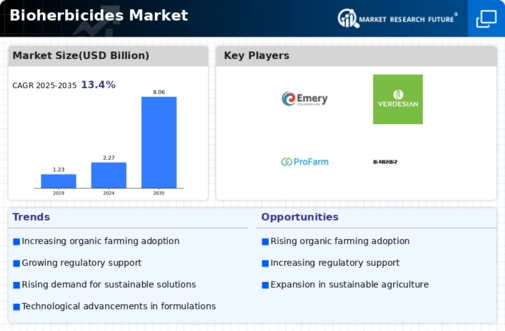Increasing Consumer Awareness
The rising consumer awareness regarding the adverse effects of synthetic herbicides is a pivotal driver for the Bioherbicides Market. As consumers become more informed about health and environmental issues, there is a growing preference for organic and sustainable agricultural practices. This shift is reflected in market data, indicating that the demand for bioherbicides is projected to grow at a compound annual growth rate of approximately 12% over the next five years. The increasing inclination towards eco-friendly products is compelling farmers and agricultural businesses to adopt bioherbicides, thereby enhancing their market presence. Furthermore, educational campaigns and initiatives by various organizations are likely to bolster this trend, as they emphasize the benefits of bioherbicides in promoting sustainable farming practices.
Government Initiatives and Policies
Government initiatives and policies aimed at promoting sustainable agriculture are significantly influencing the Bioherbicides Market. Various countries are implementing regulations that encourage the use of biopesticides, including bioherbicides, as part of their agricultural strategies. For instance, financial incentives and subsidies for farmers adopting eco-friendly practices are becoming more prevalent. Market data suggests that regions with supportive policies are witnessing a faster adoption of bioherbicides, with an estimated market growth of 15% in these areas. This regulatory support not only enhances the credibility of bioherbicides but also encourages research and development in this sector, leading to innovative solutions that meet the needs of modern agriculture.
Environmental Sustainability Concerns
Concerns regarding environmental sustainability are driving the Bioherbicides Market towards a more eco-friendly future. As the negative impacts of chemical herbicides on soil health, water quality, and biodiversity become increasingly apparent, there is a growing demand for sustainable alternatives. Market data indicates that the bioherbicides segment is expected to capture a larger share of the herbicide market, with projections suggesting a shift of approximately 25% towards bio-based solutions in the coming years. This trend is likely to be supported by consumer preferences for products that align with environmental stewardship, prompting agricultural stakeholders to invest in bioherbicides as a means to enhance their sustainability credentials.
Technological Innovations in Bioherbicides
Technological innovations play a crucial role in shaping the Bioherbicides Market. Advances in biotechnology are leading to the development of more effective and targeted bioherbicides, which are essential for meeting the demands of contemporary agriculture. Research indicates that the introduction of novel formulations and delivery systems is enhancing the efficacy of bioherbicides, making them a viable alternative to traditional herbicides. The market is expected to witness a surge in investment in R&D, with projections indicating a potential increase in market size by 20% over the next few years. These innovations not only improve the performance of bioherbicides but also contribute to the overall sustainability of agricultural practices.
Rising Adoption of Integrated Pest Management
The increasing adoption of Integrated Pest Management (IPM) strategies is a significant driver for the Bioherbicides Market. Farmers are increasingly recognizing the importance of combining various pest control methods, including the use of bioherbicides, to achieve sustainable agricultural outcomes. This holistic approach not only enhances crop yield but also minimizes the reliance on chemical herbicides. Market analysis shows that regions implementing IPM practices are experiencing a notable rise in bioherbicide usage, with estimates suggesting a growth rate of 10% in these markets. The synergy between bioherbicides and other pest management techniques is likely to foster a more resilient agricultural ecosystem, further propelling the demand for bioherbicides.
















Leave a Comment